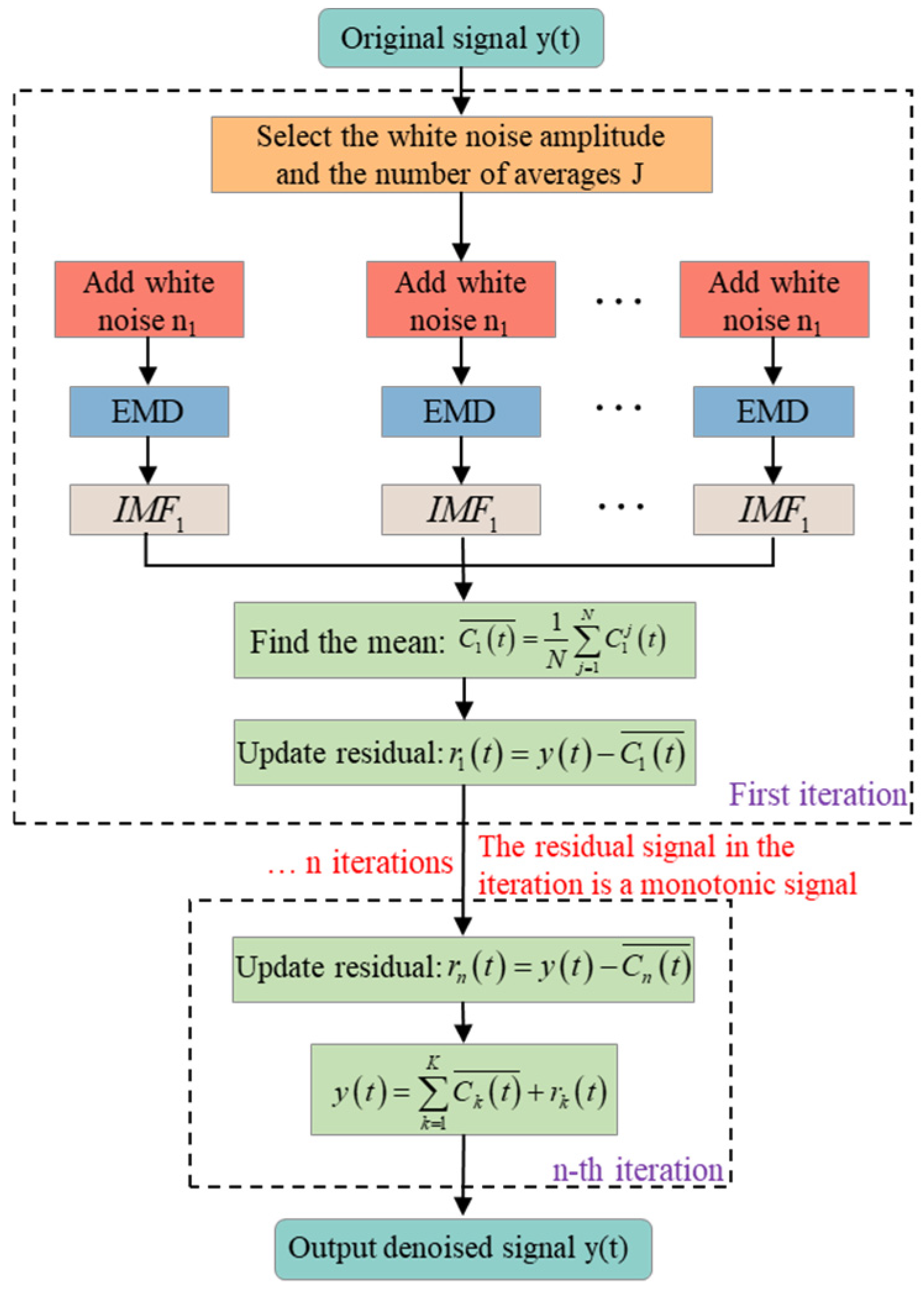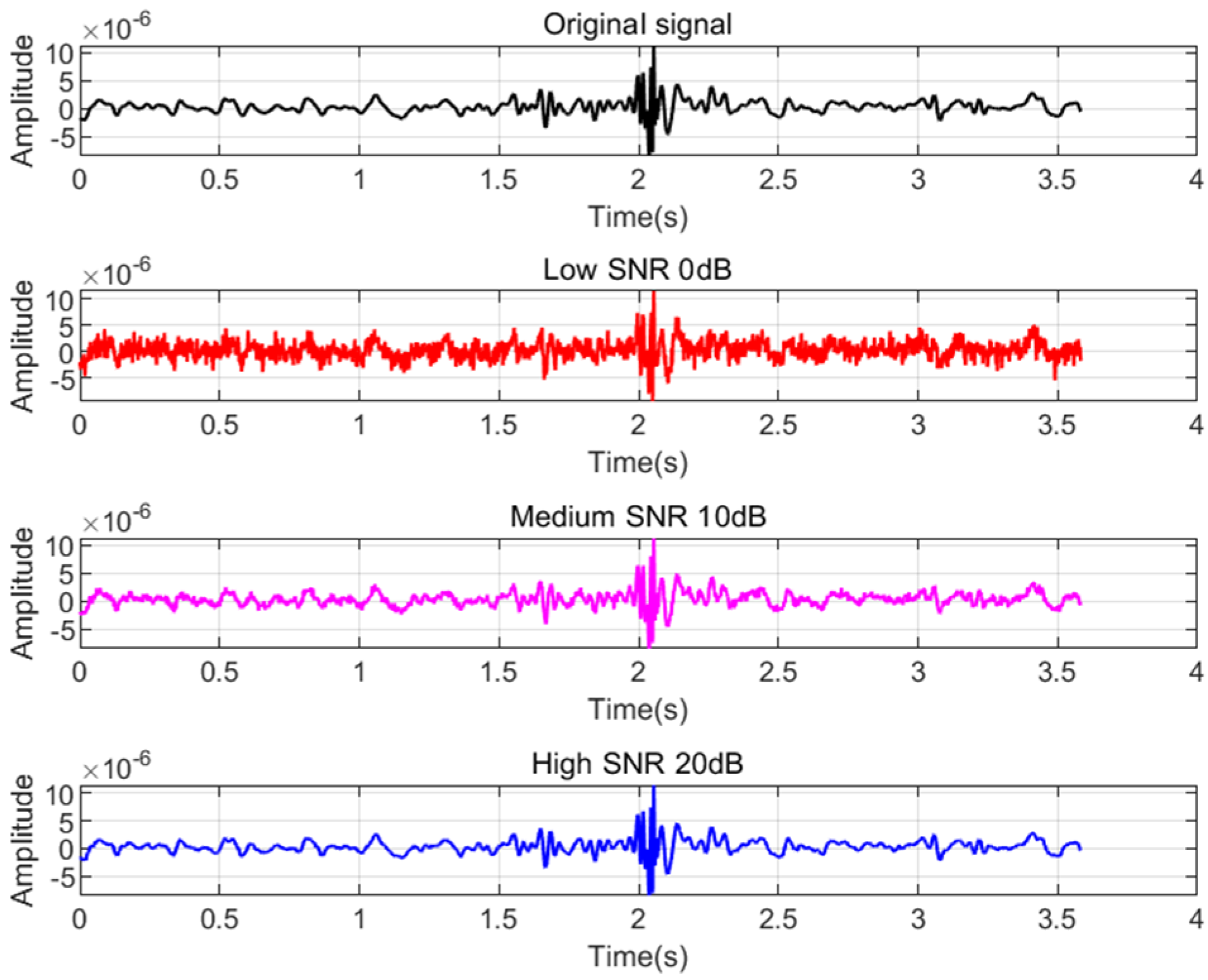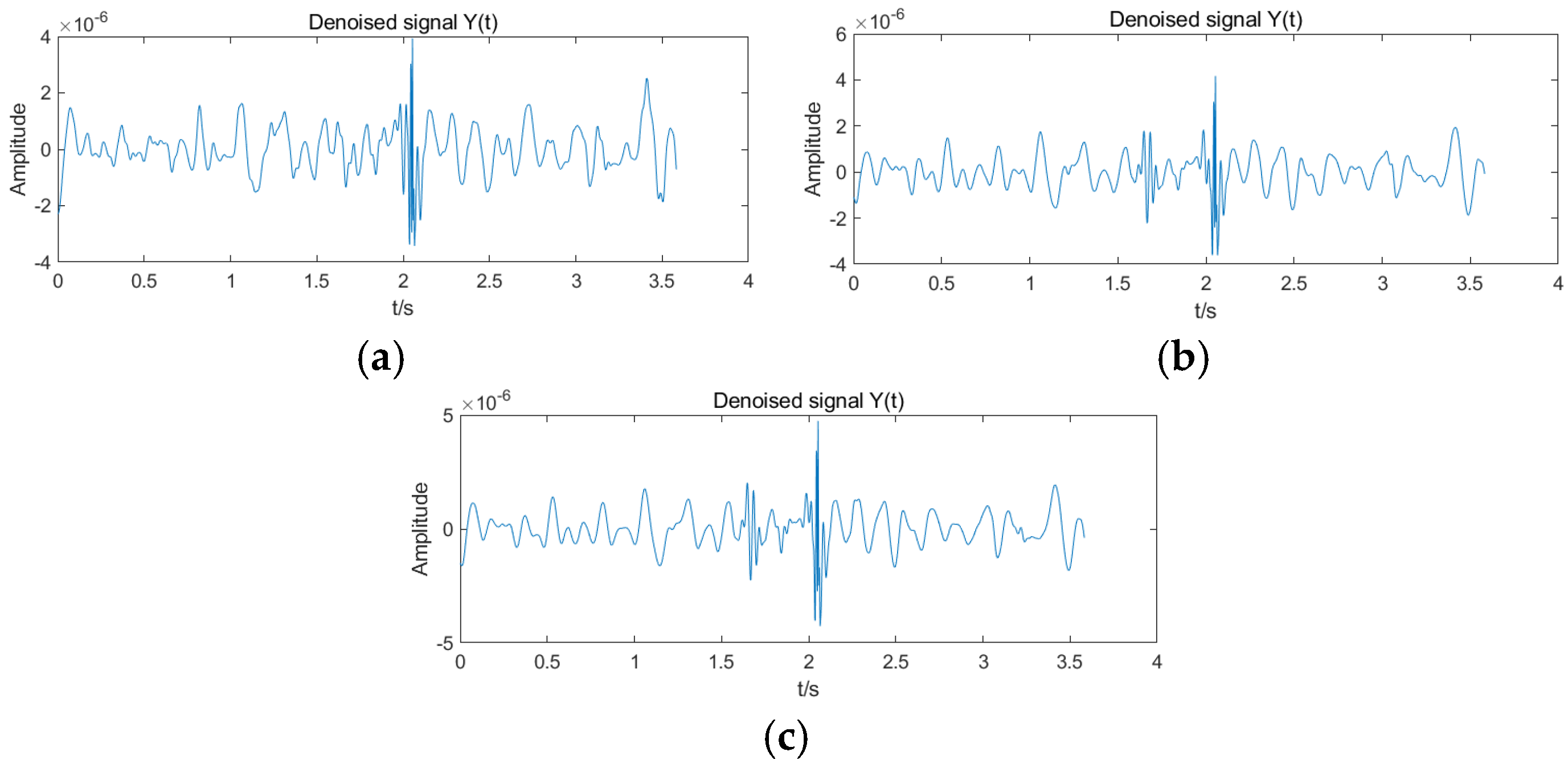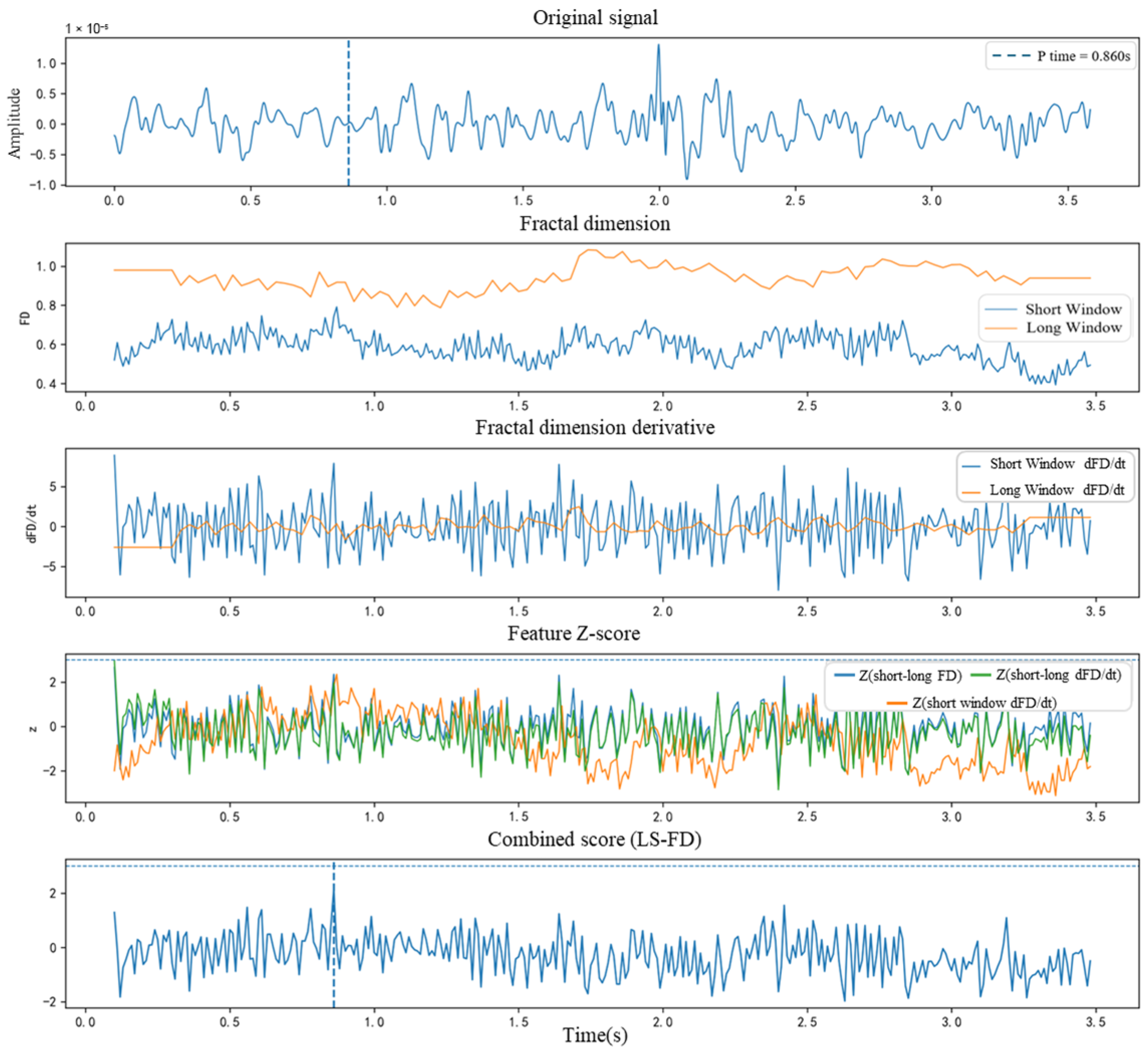2.1. Empirical Mode Decomposition
Empirical Mode Decomposition (EMD) is a typical adaptive signal processing method capable of decomposing nonlinear and non-stationary signals into a series of physically meaningful Intrinsic Mode Functions (IMFs) and a residual component [
14,
15]. Each IMF represents the characteristic oscillatory mode of the signal at a specific time scale, while the residual component describes the overall trend of the signal. The basic principle is as follows: the local extrema of the original signal are first identified, and upper and lower envelopes are constructed by interpolation; the mean of these envelopes is then subtracted from the original signal. If the resulting signal satisfies the conditions of having zero mean and a difference of no more than one between the number of extrema and the number of zero-crossings, it is considered an IMF; otherwise, the sifting process continues iteratively until the conditions are met. By repeating this process, the signal can be progressively decomposed into a set of IMFs and a residual trend term, thereby enabling the extraction of oscillatory components at different scales. A major advantage of EMD is that it is entirely data-driven and does not require predefined basis functions, making it particularly suitable for processing vibration signals with strong non-stationary characteristics.
However, traditional EMD suffers from the problem of mode mixing, where signal components from different time scales are intermixed within the same IMF, leading to decomposition results that lack clear physical interpretability. Moreover, under strong noise conditions, EMD exhibits poor stability and reproducibility in its decomposition outcomes. To address these issues, various improved methods have been proposed, among which the Complete Ensemble Empirical Mode Decomposition with Adaptive Noise (CEEMDAN) is the most representative. CEEMDAN mitigates mode mixing by repeatedly adding Gaussian white noise to the signal and performing multiple decompositions, followed by ensemble averaging of the results. In addition, CEEMDAN incorporates an adaptive noise adjustment mechanism to prevent the noise amplification effect during individual decompositions, thereby enhancing the stability of the results. Compared with EMD, CEEMDAN not only provides more accurate modal components but also significantly improves computational efficiency while maintaining decomposition precision.
The workflow of the CEEMDAN algorithm is shown in
Figure 1. Let
denote the
i-th intrinsic mode function (IMF) obtained through standard EMD, and
denote the
i-th IMF obtained through CEEMDAN. Let
represent Gaussian white noise following a standard normal distribution, j be the number of added noise realizations,
be the standard deviation of the added noise, and
be the signal to be decomposed. After decomposition, a total of
K IMFs is obtained, and the original signal
can be expressed as:
In microseismic signal processing, the advantages of CEEMDAN are particularly prominent. On one hand, it can separate high-frequency random noise into independent IMF components, which facilitates subsequent denoising; on the other hand, it effectively preserves the true structure of mid- and low-frequency signals, making the first-arrival features of seismic events clearer. In this study, a noise suppression module is constructed based on CEEMDAN, and the IMF components are further optimized using wavelet threshold denoising so as to obtain input signals with a high signal-to-noise ratio under complex noise conditions, laying a foundation for the subsequent fusion picking method based on fractal box dimension and STA/LTA.
2.2. Wavelet Threshold Denoising Parameter Optimization
Wavelet threshold denoising is a commonly used signal processing technique primarily employed to remove noise from images or waveform signals. It is based on wavelet transform, which converts the signal from the time domain to the wavelet domain and utilizes the statistical characteristics of wavelet coefficients to determine which coefficients represent noise. These noise-related coefficients are then either set to zero or adjusted to achieve the effect of denoising. The basic principle is to apply wavelet transform—typically using the Mallat algorithm—to decompose the signal, followed by selective processing of the resulting wavelet coefficients [
18]. After decomposition, the wavelet coefficients of valid signals tend to be relatively large, while those corresponding to noise are comparatively small, and the noise coefficients are generally smaller than those of the valid signal. By selecting an appropriate threshold, wavelet coefficients greater than the threshold are preserved, whereas those below the threshold are considered to originate from noise and are set to zero, thereby obtaining a denoised version of the valid signal. Therefore, the key to wavelet threshold denoising lies in the selection of an appropriate threshold.
Wavelet bases serve as the fundamental functions of wavelet transform, enabling the representation of different scales and frequency components of a signal in both the time and frequency domains. They are characterized by compactness and locality, meaning they are of finite length in the time domain and allow localized analysis in both time and frequency domains. This property enables wavelet transform to capture the instantaneous features and local details of signals more effectively [
19]. The selection of an appropriate wavelet basis function depends on the characteristics of the signal and the intended analytical objectives. Different wavelet bases exhibit distinct properties in the time and frequency domains and can be used to extract various signal components, such as frequency bands [
20], edge information, or local oscillations. Since different wavelets vary in terms of orthogonality, compact support, smoothness, and symmetry [
21]—and it is often difficult to construct a single wavelet function that simultaneously possesses all four properties—in practical applications, a trade-off must be made among these characteristics. The choice of wavelet should therefore be guided by the specific objectives and decomposition requirements of the signal being processed [
22]. Commonly used wavelet basis functions are shown in
Table 1.
To determine the wavelet basis function most suitable for microseismic signal denoising, six different wavelet bases were selected in this study. These six wavelet functions were applied to denoise the same segment of a representative microseismic signal, with a duration of 3.584 s. After denoising, the root mean square error (RMSE) and signal-to-noise ratio (SNR) of the processed signals were calculated and compared.
The root mean square error (
RMSE) is calculated as follows:
The signal-to-noise ratio (
SNR) is calculated as follows:
Here, represents the original signal, and represents the signal after denoising.
In general, microseismic waveforms have short durations and relatively low energy and amplitude, making the Daubechies wavelet family particularly suitable for wavelet threshold denoising [
23]. Comparative analysis of denoising performance shows that the db9 wavelet achieves the lowest root mean square error (
RMSE) and the highest signal-to-noise ratio (
SNR). Specifically, the RMSE is reduced by 14.02% compared with the db6 wavelet, and the peak SNR is increased by 36.11% compared with the biorN5.N5 wavelet. Therefore, the wavelet threshold denoising algorithm based on the db9 wavelet exhibits optimal performance. Accordingly, this study selects the Daubechies wavelet family with an order of 9, i.e., db9. The computational results are presented in
Table 2.
Microseismic signals have typical characteristics such as transient abrupt changes, short duration, and concentrated spectra. The P-wave has a steep rise, with energy distributed in the mid-to-high frequency range, and is often masked by strong background noise. To preserve the abrupt change information in the time domain and achieve noise separation in the frequency domain, it is required that the wavelet basis possess good time-frequency locality and smoothness.
The Daubechies wavelet family is known for its compact support and high-order vanishing moments, effectively balancing time and frequency resolution. The db9 wavelet, with nine vanishing moments, can accurately represent abrupt changes and edge information while maintaining smooth reconstruction of the signal. Its orthogonality ensures the independence of components at different scales, preventing energy leakage; its nearly symmetric waveform helps reduce phase distortion, making the P-wave arrival time detection more stable [
24]. Additionally, the frequency bandwidth of db9 closely matches the main frequency range (20–80 Hz) of typical mining microseismic signals, allowing accurate separation of low-frequency background and useful wave components at different decomposition levels, thereby maximizing suppression of high-frequency random noise while preserving the characteristics of the P-wave rise.
Therefore, theoretically, the db9 wavelet possesses sufficient smoothness, time resolution, and spectral matching, making it an optimal choice for denoising and feature extraction of mining microseismic signals, capable of accurately capturing transient changes in these signals.
In microseismic monitoring signals, the coefficients corresponding to the valid signal are relatively large, while those corresponding to noise are smaller but still follow a Gaussian distribution. By setting a threshold to zero the coefficients of noise signals, the noise can be maximally suppressed, while causing minimal damage to the valid signals. Considering that some acquisition equipment can sample up to 2500 Hz, to avoid the high sampling rate introducing high-frequency noise into the wavelet coefficients, a 200 Hz anti-aliasing low-pass filter is applied to the data before processing, and the data is resampled to 500 Hz. High-frequency signals occupy a certain proportion in the collected data. To prevent excessive attenuation of wavelet coefficients—which could result in the loss of high-frequency information—this study adopts the SUREShrink threshold based on the Stein’s Unbiased Risk Estimation (SURE) criterion. This threshold orders the squared wavelet coefficients in ascending order, sets a threshold
to estimate its likelihood, and then minimizes the non-likelihood to obtain the final threshold. The formula for this threshold is as follows:
In Equation (4), the threshold t is the variable adjusted to minimize the objective function; where σ represents the standard deviation of the noise, which is estimated using the median absolute deviation method from the noise segment before the event or from the finest scale wavelet detail subband.
The SUREShrink threshold is applicable to the soft threshold function. To avoid signal discontinuities and maximize the reconstruction of a smooth signal, the soft threshold function is selected as the thresholding function for wavelet threshold denoising. The soft threshold function is defined as follows:
represents the wavelet detail coefficient of the signal at scale j and time k after performing the discrete wavelet transform.
In summary, this study ultimately selects the db9 wavelet basis combined with the SUREShrink threshold and the soft threshold function as the parameter set for microseismic signal denoising, providing high-quality input signals for the subsequent fractal dimension and STA/LTA integrated arrival picking. This choice not only ensures the stability and reliability of the processed results but also lays a solid foundation for improving the accuracy of P-wave arrival identification.



















